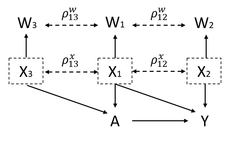Comparative effectiveness research
Which interventions work best?
|
Comparative effectiveness research is growing in importance in public health and medicine as interest in patient-centered outcome research and personalized medicine is increasing. My research focus on developing Bayesian hierarchical models for network meta-analysis. Network meta-analysis compares the effectiveness (and/or safety) of multiple treatments in a principled way to find the best treatment.
|
Causal inference and measurement error
Does your data measure covariates correctly?
|
Non-experimental studies are used to estimate causal effects, but they are not perfect; for example, they often measure some covariates with error (e.g., self-reported income) and use different measurement between treated and control groups. These measurement errors could lead to biased estimates of treatment effects. I have contributed to developing propensity score methods under the Bayesian framework for handling complex covariate measurement error structures.
|
Generalizability of study findings to target populations
What is the population average treatment effect?
|
The external validity of randomized controlled trials and how to generalize the results of trials to target populations are an important issue especially when we want to translate the results to community settings. I have recently started to develop methods that bridge the two fields, meta-analysis and generalizability. This work will provide guidance on how to draw population inferences from meta-analysis, an important practical question of interest in public health.
|
Synthetic / external control in clinical trials
How can we use historical clinical trials or real-world data in a prospective clinical trial?
The use of external controls in clinical trials for regulatory purposes has been actively discussed in FDA especially for rare diseases, where subjects are scarce, or medical products in areas of high medical need. This work will provide rigorous ways to validate fitness for purpose of the external controls and statistical methodologies to borrow information properly and adaptively from the external controls.
Collaborative work
In addition to the major methodological developments described above, I have been involved in several applied projects in diverse areas of research, and greatly enjoy the opportunity to work with collaborative teams and develop methodological projects directly motivated by real world problems.


